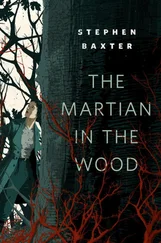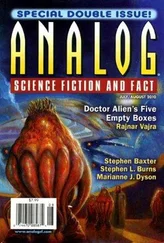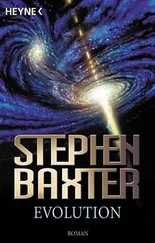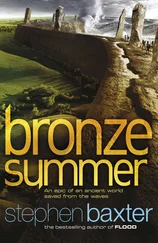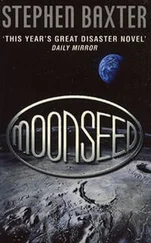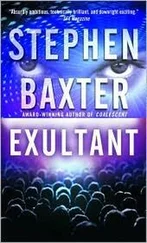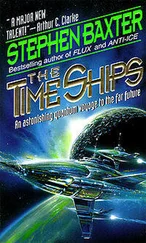It was an asteroid.
It was misshapen and almost black, the craters and cracks of its dusty surface picked out by unvarying sunlight, a potato left too long on the barbecue. And a spacecraft of rippling gold was approaching, dwarfed by the giant rock.
There was applause, whooping. Way to go, Dan! Right down U.S. One.
Dan fumbled at a touchpad, and a new image came up on the softscreen: Sheena 5, a Caribbean reef squid, drifting in blue-gold shadows, live from Nautilus. Eerily, her head was hidden by a metal mask that trailed wires back to a mass of machinery.
Then the cephalopod pulled back, leaving the metal mask dangling in the water, and she began an elaborate dance. It was enchanting: her chromatophore organs pulsed with colors and shapes, black and orange and aquamarine and ocher, and her tentacles and arms flashed as she arced, twirled, and pirouetted through the tank. She was very obviously producing signals: one, even two a second, signals that flowed into each other, varying remarkably in their intensity.
Can you interpret what she s saying, Dan?
Hesitantly he began to translate.
“Stop and watch me. Stop and watch me. You have to understand her language elements are based on those she inherited from the cephalopod shoals. This is a signal she might use to distract prey, or even a predator.
“Now this is what we call the pied pattern. Court me. Court me. She’s asking for admiration. She’s proud. Asteroid. Come near. Come near. Another mating signal. It’s as if she’s luring the asteroid. Star shoal all around. No danger, no danger. Literally, no predators. But she means that her navigation has been a success, that the systems are working nominally. Stop and watch me. Court me. . .”
His posture was stiff as he stared at the screen, the separation from his dancing friend a tangible, painful thing.
The audience was silent, Maura noted absently: stunned by this shard of cheap emotion.
The digital displays told her the moment of rendezvous was near. The remote firefly-camera images returned to the soft-screen, a stop-start sequence updated every few seconds. The gold spark tracked across the blackened surface.
Sheena 5:
The asteroid was big now, covering almost half of the sky.
She could see the asteroid’s surface, as if she were drifting over Caribbean sand flats. It was dull and dark. But its polarization was rich. She was searching for the shading and twinkling that meant frozen water. Here was a patch where the twisting of the light was muddy and random, and Dan had taught her that meant bare metal. Here the light was strongly polarized, and the surface was probably coated with thick, sticky dust. It seemed wonderful to Sheena that she could clearly see, just by looking at the sparkling, twisting light, what this strange deep-space fish was made of.
There. It looked like a hole in the surface, and it had a shallow, sloping floor that sparkled and gleamed with the look of water.
Sheena touched her waldoes, and the ship hovered above the depression.
She knew it would take a long time for Dan to learn of her success. She trembled with anticipation.
Gripping the circular support with her arms, Sheena inserted her two long tentacles into the smooth, flexible sheaths, and touched the central pad with her beak.
Two three-hundred-foot cables, aping the motion of her tentacles, began to unwind from the hull of Nautilus. Sheena extended her tentacles, and small puffs of gas from the pads at the cable ends sent them stretching toward the asteroid. She allowed the cables to droop to their limits, then flashed down to the ship’s software.
She sensed the cables touch the bottom, touch the asteroid. Contact.
She flexed her suction cups to grip the surface. Slowly she contracted her tentacles, drawing herself down until she could see the smallest details of the asteroid, even her ship’s small shadow.
She had practiced this maneuver in deep space, over and over. It was probably the most important task she would ever have to complete, after all; if she failed at this one thing, the mission itself would fail.
Finally she felt a gentle pressure wave pulse through the water and through her own body, letting her know that she had come to rest.
The asteroid, this great black whale of space, was her prey, and she, the hunter, had captured it.
Pride surged, chromatophores pulsing over her body.
Gabriel Marcus
Some minor planets, of course, already have roles in astrology. Since these worlds weren’t known to the ancients, their roles are the subject of modern interpretation and some debate.
So it is proving with Cruithne.
Perhaps we can take some guidance from the derivation of the name. The Cruithne was the old Irish name for the Pictish people. In the twelfth-century Irish document “List of Pictish Kings,” Cruithne is given as the eponymous ancestor of the Pictish people, and it was his seven sons who gave their names to the divisions of the Pict kingdom in Scotland.
But the Cruithne was also used by the Irish to describe a group of aboriginal people living in Ireland before the coming of the Gaels. They seem to have been at one time the predominant power in Ulster.
A further blurring of the name’s meaning comes from the fact that some early writers claim that Pictish lineage was traditionally taken from the mother’s line, not the father’s. So perhaps Cruithne — if such an individual existed at all — was not a man, but a woman.
As far as its astronomical properties go, Cruithne is again an unusual world.
Perhaps uniquely among astrological subjects, it wanders far from the plane of the ecliptic and far from the traditional Houses; in fact at times it can be seen, by telescope, above (or beneath) Earth’s poles. And yet it is intimately linked to Earth; we know that its peculiar “horseshoe” orbit is dominated by Earth’s gravity.
And, of course, the most direct link of all has now been established, as the squid, Sheena, has become the first Earth creature since the Apollo astronauts to reach another world.
Cruithne: mother-father, person, and people — linked to Earth by spidery webs of influence and life. Little wonder that this tiny, remote, ambiguous world is causing such a stir in astrological circles.
It is of course true, but irrelevant, that the name Cruithne was a late choice among the Australian astronomers who named the minor planet. An earlier suggestion was an irreverent nickname for one of their number, the Chunder Wonder. We can be grateful — if not surprised — that destiny guided the correct choice.
Sheena 5:
She could not leave her water habitat; yet she was able to explore.
Small firefly robots set off from the habitat, picking their way carefully over the surface of the asteroid. Each robot was laden with miniature instruments, as exquisite as coral, all beyond her understanding.
But the fireflies were under her control.
She used the waldo, the glovelike device into which she could slip her long prehensile arms and so control the delicate motions of each firefly. Cameras mounted in the carapace of the firefly brought her a view through her laser eyecup of what the firefly was seeing, as if she were swimming alongside it. The gravity was so low that a careless movement would have sent the little metal devices spinning away from the surface, to be lost forever. So the limbs of the fireflies carried hooks and suction devices to ensure that at every moment they were anchored to the thin re-golith. And, with delicacy and care, she was able to ensure the fireflies avoided ravines and deep craters, and so were never in danger.
Читать дальше
Конец ознакомительного отрывка
Купить книгу

